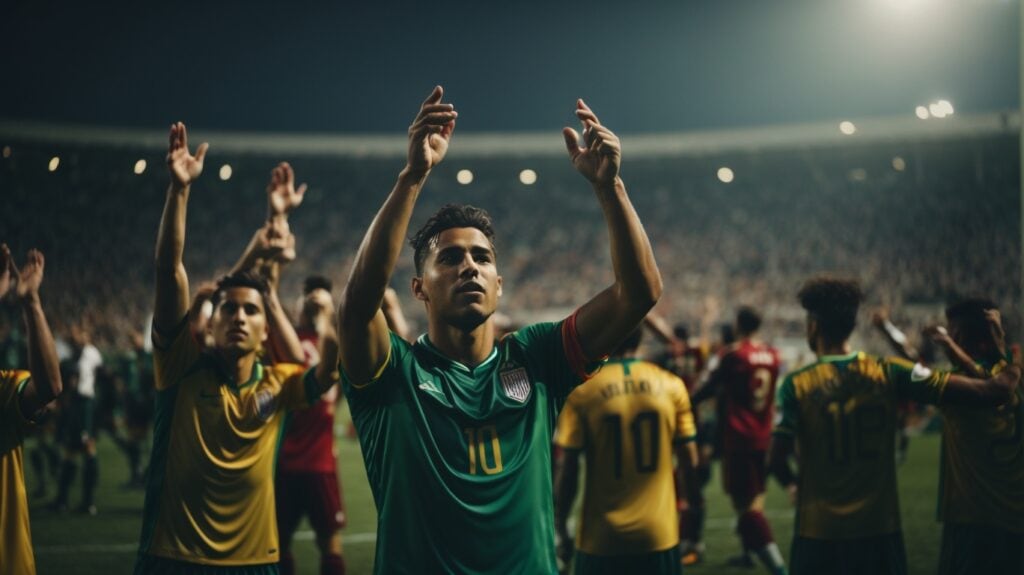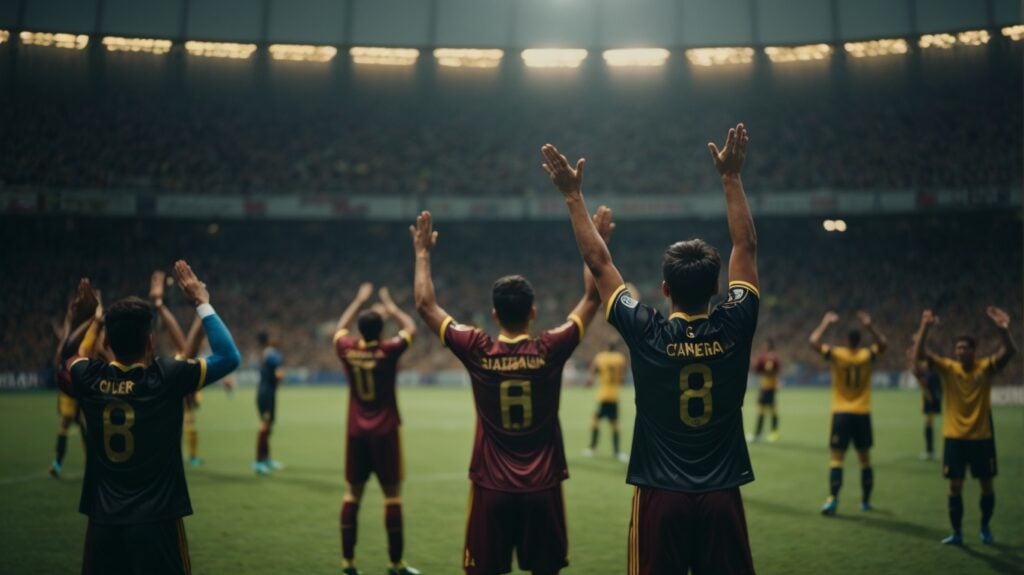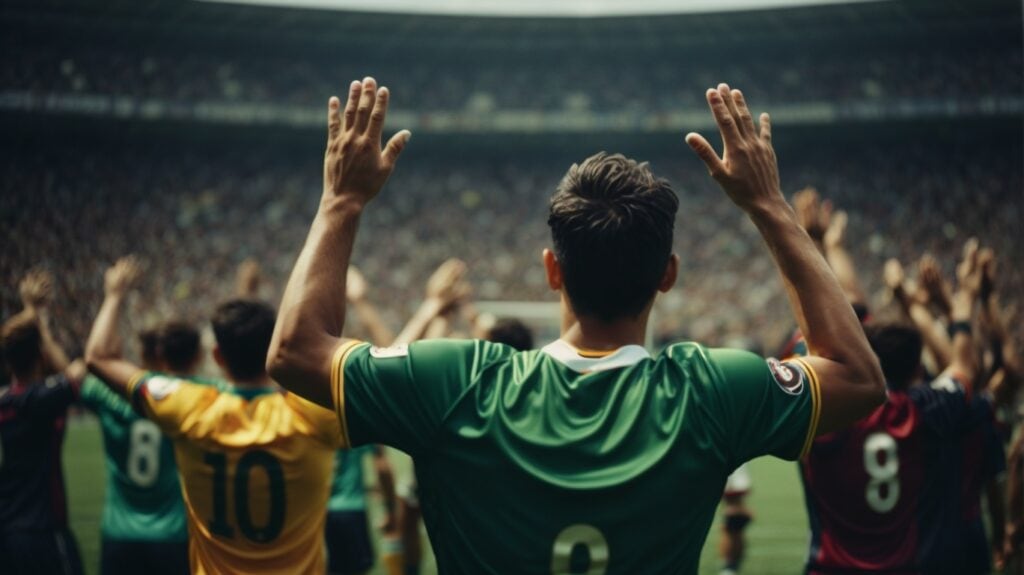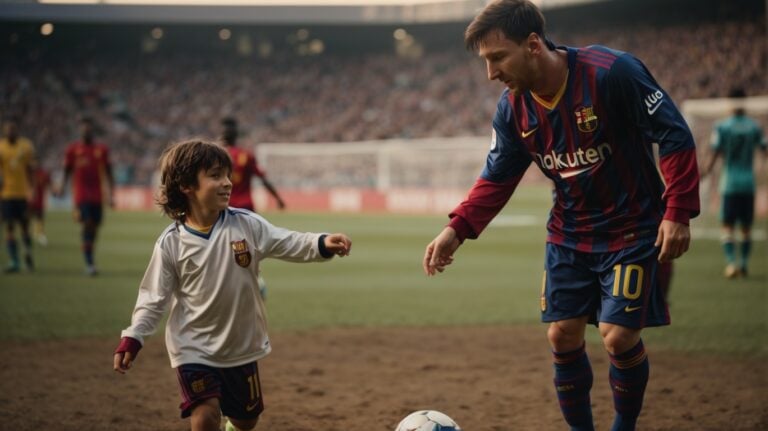Soccer is a game that is often referred to as “the beautiful game.” It is a sport that captivates millions around the world with its thrilling matches, incredible skill, and passionate players. One aspect of the game that has intrigued fans for generations is the act of soccer players raising their hands during matches. In this article, we will explore the various reasons why soccer players raise their hands and the significance of this action on the field.
Understanding the Basics of Soccer

Before delving into the intricacies of hand gestures in soccer, it is essential to grasp the basics of the game. Soccer, also known as football in many parts of the world, is a team sport played with two teams of eleven players each. The objective is to score goals by kicking the ball into the opposing team’s net. The game is played on a rectangular field, typically made of grass or artificial turf, with goals at each end.
Soccer is a sport that has a rich history dating back centuries. It originated in England and has since become one of the most popular sports globally, with millions of fans and players worldwide. The game is known for its simplicity and universal appeal, as it can be played by people of all ages and skill levels.
The Role of Hand Gestures in Soccer
Soccer is a fast-paced game that requires constant communication among teammates. While verbal communication is essential, hand gestures also play a crucial role in this communication process. When a player raises their hands, it is often a way of conveying specific messages to their teammates.
One common hand gesture in soccer is the signal for a pass. When a player wants to indicate that they are ready to receive a pass, they may raise their arm and point to an open space on the field. This gesture helps their teammates understand where they should direct the ball.
Hand gestures can also be used to indicate a change in tactics. For example, a player may raise their hand and make a circular motion, signaling their teammates to switch from an offensive to a defensive strategy. These gestures allow players to communicate quickly and effectively, even in the midst of a fast-paced game.
Another important hand gesture in soccer is the signal for offside. When a player is in an offside position, meaning they are closer to the opponent’s goal line than both the ball and the second-to-last defender, they can be penalized. In such situations, a player may raise their flag or arm to alert the referee and their teammates of the offside offense.
In addition to these specific hand gestures, soccer players often use non-verbal cues to communicate with each other during a game. These cues can include eye contact, body movements, and even facial expressions. The ability to understand and interpret these signals is crucial for effective teamwork and coordination on the field.
It is important to note that hand gestures in soccer are not limited to players. Coaches and referees also use hand signals to communicate various instructions and decisions during a game. These signals help maintain order and ensure that the game is played fairly.
In conclusion, hand gestures play an integral role in soccer, facilitating communication among teammates and helping to convey important messages during a game. Understanding these gestures is essential for players, coaches, and referees alike, as they contribute to the overall dynamics and success of the game.
The Significance of Raising Hands in Soccer

The act of raising hands in soccer carries deep significance and can impact the outcome of a match. Let us explore some of the reasons behind this common practice.
Communication with Teammates
Raising hands in soccer is primarily a form of non-verbal communication among players. It allows them to convey their intentions and coordinate their movements on the field. For example, a player may raise their hand to indicate that they are open and ready to receive a pass. This simple gesture enables seamless teamwork and enhances the fluidity of the game.
Furthermore, raising hands can also be used to signal specific tactics or strategies to teammates. For instance, a player may raise both hands to indicate the need for a quick counter-attack or a change in formation. This kind of communication can be crucial in high-pressure situations, where verbal communication may be difficult due to the noise of the crowd.
Signaling for Offside
In soccer, the offside rule dictates that an attacking player cannot receive the ball if they are closer to the opponent’s goal than both the ball and the second-to-last defender. Raising hands in soccer can be used to signal the referee or linesman that an offside offense has occurred. This action draws attention to the infringement and allows the officials to make the correct decision.
Moreover, players often raise their hands to protest against a perceived offside violation. By doing so, they express their disagreement and hope to influence the referee’s judgment. This tactic is particularly common when a goal is scored, and the defending team believes that an offside position was involved. The raised hands serve as a visual representation of their protest, urging the officials to review the situation.
Attracting Referee’s Attention
Soccer players may also raise their hands to attract the referee’s attention. In the midst of a fast-paced game, it can be challenging for the referee to spot minor fouls or infringements. By raising their hands, players can draw the referee’s gaze to the incident, increasing the chances of an appropriate response. This tactic is often employed to seek justice and maintain fairness on the field.
Additionally, raising hands can be used strategically to highlight unsporting behavior by opponents. For example, if a player is subjected to a foul or aggressive behavior, they may raise their hands to signal to the referee that they have been wronged. This action not only alerts the officials but also serves as a deterrent to the opposing player, as they become aware that their actions are being closely monitored.
In conclusion, raising hands in soccer is more than just a simple gesture. It serves as a powerful tool for communication, signaling offside violations, and attracting the referee’s attention. This practice enhances the dynamics of the game and contributes to maintaining fairness and sportsmanship on the field.
The Rules and Regulations Surrounding Hand Gestures

While hand gestures serve as a vital component of soccer, there are rules and regulations in place to ensure their responsible use. These guidelines help maintain the integrity of the game and prevent the gestures from being misused.
Hand gestures in soccer have a long history and are used by players to communicate with their teammates on the field. These gestures can convey various messages, such as indicating a specific play or strategy, calling for a pass, or signaling a change in tactics. They are an essential part of the game, allowing players to coordinate their movements and make split-second decisions.
FIFA’s Stance on Hand Gestures
FIFA, the governing body of soccer, provides specific guidelines regarding hand gestures during matches. According to FIFA’s regulations, hand gestures should not be offensive, aggressive, or provocative. Players are expected to use hand gestures solely for communication purposes and not for inciting conflict or disrespecting opponents.
One of the reasons behind FIFA’s strict stance on hand gestures is to maintain the spirit of fair play. Soccer is a game of skill, strategy, and teamwork, and any actions that deviate from these principles can undermine the essence of the sport. By enforcing rules on hand gestures, FIFA aims to ensure that players use them in a respectful and sportsmanlike manner.
Consequences of Misusing Hand Gestures
If a player misuses hand gestures, such as using them in an offensive or unsportsmanlike manner, they may face disciplinary actions. Consequences can range from receiving yellow or red cards to being suspended from future matches. Such penalties serve as a deterrent against the misuse of hand gestures and reinforce fair play.
The severity of the punishment depends on the nature and intent of the hand gesture. For instance, a player who makes a harmless hand signal to his teammate is unlikely to face any consequences. However, if a player uses a hand gesture to taunt or provoke an opponent, it can lead to immediate disciplinary action.
Referees play a crucial role in enforcing the rules surrounding hand gestures. They are responsible for observing the players’ actions on the field and taking appropriate action if any violations occur. Referees receive training to identify gestures that cross the line and ensure that the game remains fair and respectful.
It is important for players to understand the significance of hand gestures and use them responsibly. By adhering to the rules and regulations set by FIFA, players can contribute to a positive and enjoyable soccer experience for everyone involved. Hand gestures, when used properly, enhance communication and teamwork, creating a more cohesive and exciting game.
Famous Instances of Hand Raising in Soccer History

Throughout soccer’s rich history, there have been numerous memorable moments involving hand gestures. These instances have shaped the way we perceive hand raising in soccer and have left lasting impressions on fans worldwide.
Hand raising in soccer is not only a physical act but also a symbolic gesture that can have significant consequences on the outcome of a match. From controversial moments to displays of sportsmanship, hand raising has become an integral part of the game.
Controversial Hand Raising Moments
One of the most infamous instances of hand raising in soccer history occurred during the 1986 FIFA World Cup quarter-final match between Argentina and England. Argentinean captain Diego Maradona raised his hand and seemingly punched the ball into the net, a maneuver later known as the “Hand of God” goal. This controversial act sparked debates and highlighted the ambiguity and impact of hand gestures in the game.
The “Hand of God” goal not only showcased Maradona’s skill and cunning but also raised questions about the ethics of using one’s hand to gain an advantage in soccer. The incident ignited a heated discussion about fair play and the role of referees in preventing such actions on the field.
Another controversial hand raising moment took place during the 2010 FIFA World Cup quarter-final match between Uruguay and Ghana. In the dying moments of the match, Uruguayan striker Luis Suarez intentionally used his hand to block a certain goal by Ghana’s Dominic Adiyiah. Although Suarez received a red card and Ghana was awarded a penalty kick, they failed to convert it, ultimately losing the match.
This incident not only highlighted the desperation and determination of players in crucial moments but also raised questions about the consequences of such deliberate handball actions. It led to discussions on whether harsher punishments should be implemented to deter players from resorting to hand raising as a last-ditch effort to save their team.
While controversial hand raising moments often dominate headlines, there have been instances where hand gestures in soccer have showcased sportsmanship and fair play. These moments serve as a reminder that not all hand raising actions are intended to deceive or gain an unfair advantage.
In a 2006 UEFA Champions League match between Barcelona and Chelsea, Barcelona’s goalkeeper, Victor Valdes, raised his hand to acknowledge that the ball had crossed the goal line after a shot by Chelsea’s Frank Lampard. Despite the referee initially ruling it as a non-goal, Valdes’ honesty and sportsmanship prompted the referee to reverse his decision and award Chelsea the goal.
This act of sportsmanship not only earned Valdes respect from players and fans alike but also demonstrated the importance of integrity in the game. It showed that even in highly competitive matches, fair play and honesty should be valued above all.
Hand raising in soccer is a complex and multifaceted aspect of the game. It can evoke emotions of joy, anger, and controversy, often shaping the narrative of a match or a player’s career. Whether it’s a controversial handball goal, a deliberate handball to prevent a goal, or an act of sportsmanship, hand gestures in soccer will continue to captivate and intrigue fans for years to come.
How Hand Raising Affects Soccer Strategy

The act of raising hands in soccer goes beyond mere communication; it can significantly influence the strategies employed by teams during matches.
Impact on Defensive Tactics
In soccer, defensive strategies are crucial for preventing the opposing team from scoring. Hand gestures play a role in the coordination of defensive efforts. For instance, defenders may raise their hands to signify the offside trap, a strategy aimed at catching attacking players in an offside position. This tactical use of hand gestures adds another layer of complexity to the game.
Influence on Offensive Plays
On the offensive side of the game, hand gestures can impact the strategies employed by attackers. A well-executed hand signal can establish the desired movement and positioning of players. For example, raising hands can indicate a set play, allowing teammates to anticipate each other’s movements and create scoring opportunities.
Conclusion: The Unspoken Language of Soccer

In summary, soccer players raise their hands for a variety of reasons, each contributing to the overall dynamics of the game. Hand gestures serve as a means of non-verbal communication, enabling teammates to coordinate their actions effectively. Additionally, they play a significant role in the execution of defensive and offensive strategies.
It is important to recognize that hand raising in soccer must be done responsibly, adhering to the rules and regulations set forth by FIFA. By respecting these guidelines, players ensure fair play and maintain the spirit of the game.
Soccer’s unspoken language, communicated through hand gestures, adds an element of artistry and finesse to the sport. The next time you watch a soccer match, pay close attention to the intricate movements and raised hands of the players. Behind each gesture lies a message that contributes to the beautiful game we all love.







